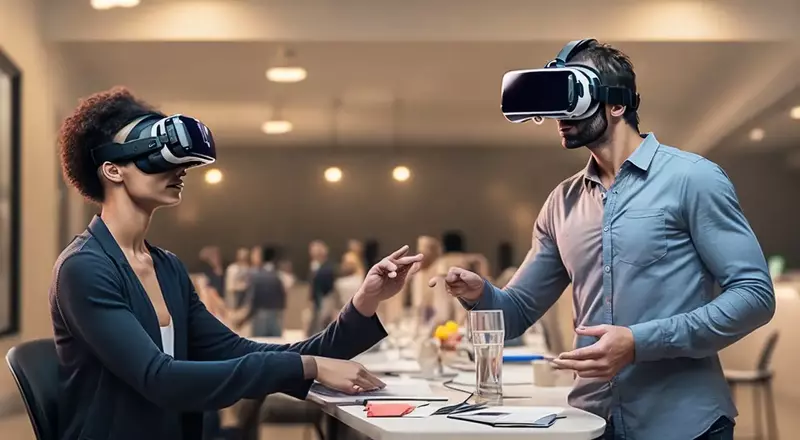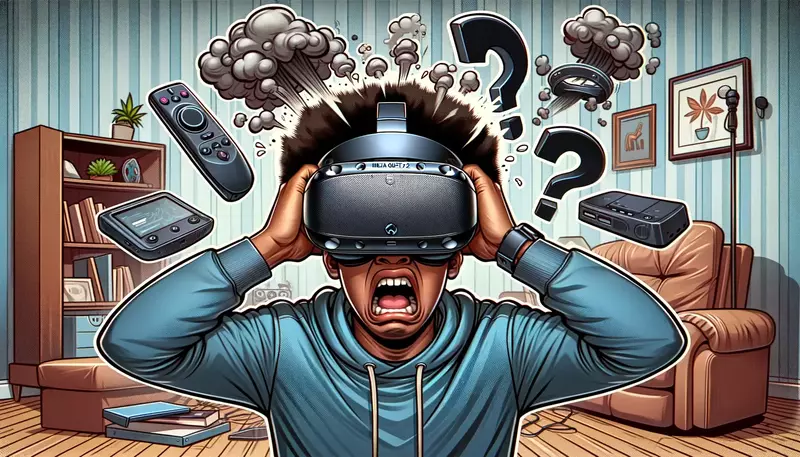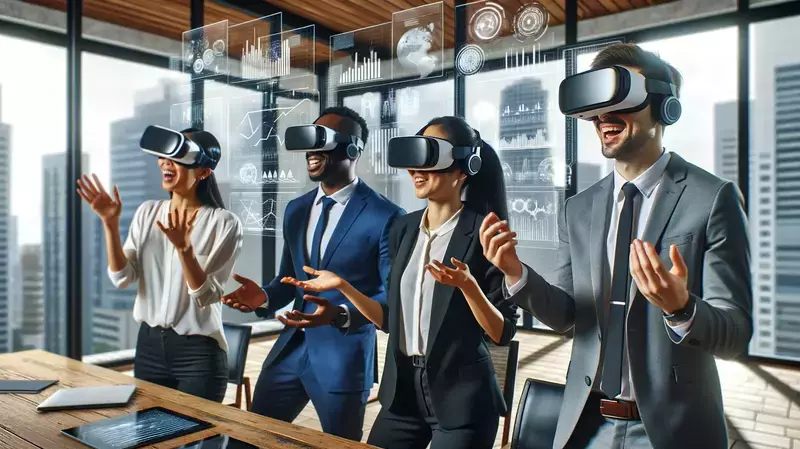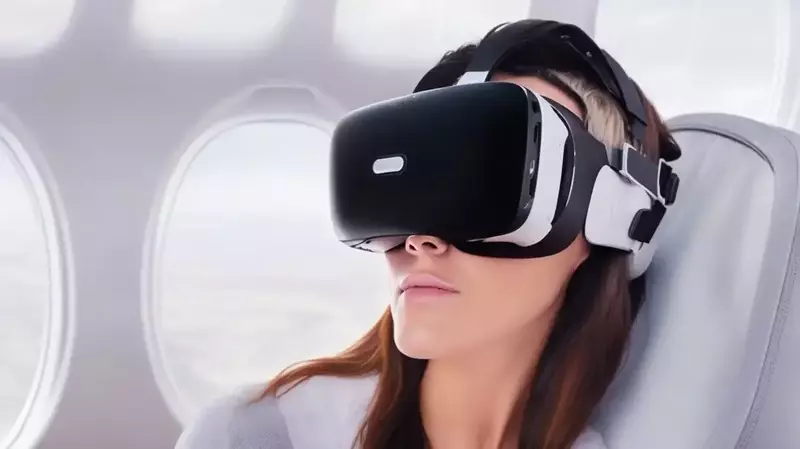This site contains affiliate links to products, and we may receive a commission for purchases made through these links.
Does virtual reality affect communication? This intriguing question has captured the attention of technophiles and communication experts alike. As VR advances, it’s critical to comprehend the effects this immersive experience has on our capacity for interacting with others.
This blog post will explore various aspects of virtual reality communication, delving into its advantages and disadvantages. We’ll also examine whether VR could become a predominant communication medium in the future.

What is Virtual Reality Communication?
Virtual reality communication, or VR communication, is like regular communication, but with a virtual twist. It’s like being in a video game, but instead of fighting dragons, you’re talking to people.
With VR technology, you can create an immersive and interactive experience for users during conversations. With VR technology, users can virtually interact with each other as if they were in the same room despite physical distance.
The Basics of VR Communication
VR communication involves wearing a headset that tracks your movements and displays computer-generated images on screens close to your eyes. You can also use handheld controllers or gloves to interact with the virtual environment.
It’s like having a capability that allows you to traverse various locations and manipulate objects in ways that are not feasible in the real world.
Different Types of VR Communication Platforms
- Social VR platforms: Hang out with friends, play games, or collaborate on projects in virtual spaces like VRChat, Rec Room, and Facebook Horizon Workrooms.
- Gaming: Play games with other people and express yourself using gestures and body language within the game world.
- Educational purposes: Attend lectures remotely and interact with teachers and classmates in a more engaging manner than traditional video conferencing solutions allow.
VR Communication in the Business World
Companies are using VR technology to conduct meetings, training sessions, and product demonstrations in a more immersive way. This can lead to increased engagement from participants and improved collaboration between team members.
Using VR technology, you can experience the same level of presence as if you were in the same room with your colleagues, even when working remotely.
The Role of Avatars in VR Communication
In most VR communication platforms, you create a digital representation of yourself called an avatar.
Avatars make it feasible to communicate non-verbally, such as through facial expressions or body language, adding a further dimension to conversations that would otherwise be impossible via plain text or voice chat.
It’s like having a digital alter ego that can express your emotions and personality.
Virtual reality communication is changing the way we interact with each other, both personally and professionally. It’s like having a superpower that lets you connect with people in ways that were once impossible. Who knows what the future holds for VR technology, but one thing’s for sure: it’s going to be exciting.
Key Takeaway:
Virtual reality communication is a new way of interacting with people that involves wearing a headset and using handheld controllers or gloves to interact with the virtual environment. It can be used for socializing, gaming, education, and business purposes. Avatars allow for non-verbal cues like body language or facial expressions to be conveyed during conversations, adding another layer of depth to interactions.
Advantages of Virtual Reality Communication
Virtual reality communication has become increasingly popular in recent years and for good reason. This innovative technology offers numerous advantages that can enhance our interactions with others personally and professionally.
Let’s explore some of the key benefits:
Increased Engagement
Virtual reality encourages active participation and fosters deeper connections between individuals or groups. Users are more likely to be fully present during conversations when they feel like they’re actually “there” with their conversation partners.
Improved Collaboration
Virtual reality facilitates improved collaboration among team members. With features such as shared whiteboards and 3D models, participants can work together on projects in real time despite being physically separated by distance or time zones.
Real-Time Feedback:
- VR allows for instant feedback on ideas or designs from colleagues located anywhere around the world.
- This eliminates delays associated with traditional methods like email exchanges or video calls.
- The result is faster decision-making processes and increased productivity overall.
Enhanced Team Building:
- Participating in immersive group activities within a virtual environment helps build trust among team members who may not have had an opportunity to interact face-to-face.
- These shared experiences can lead to stronger working relationships and improved team dynamics.
Enhanced Learning Experiences
Virtual reality communication also has the potential to revolutionize education by providing enhanced learning experiences. By simulating real-world scenarios, VR allows students to practice skills or explore new concepts in a safe, controlled environment.
This technique of active learning encourages better storage and honing of information compared to traditional teaching strategies.
Immersive Language Learning:
- Language learners can practice speaking with native speakers in virtual environments that mimic actual locations where the target language is spoken.
- This immersive experience helps build confidence and fluency faster than textbook-based learning alone.
Medical Training:
- In medical training, students can use VR simulations for practicing surgical procedures or diagnosing patients without risking harm to real individuals.
- This provides invaluable experience before transitioning into real-life clinical settings.
In summary, virtual reality communication offers numerous advantages that have the potential to transform how we connect with others both personally and professionally.
From increased engagement during conversations to enhanced collaboration among teams and innovative educational opportunities, this technology is poised for continued growth as its capabilities expand further.
Key Takeaway:
Virtual reality communication offers numerous advantages such as increased engagement, improved collaboration, real-time feedback, enhanced team building and learning experiences. It has the potential to revolutionize education by providing immersive language learning and medical training simulations for students. VR technology is poised for continued growth in the future.
Disadvantages of Virtual Reality Communication
Virtual reality communication has its perks, but it’s not all sunshine and rainbows.
Here are some potential drawbacks to keep in mind:
Privacy Concerns
In a world where hackers and snoops are lurking around every corner, privacy is a major concern for virtual reality users. VR platforms collect personal data like user behavior and preferences, which third parties could exploit.
Choose VR platforms with robust security measures and stay informed about digital privacy best practices to protect yourself.
Technical Difficulties
Though VR is built on advanced tech, it can still be subject to technical difficulties that may disrupt the experience.
There are plenty of ways VR can go wrong, from software bugs to hardware malfunctions to network connectivity problems. Some users may even experience motion sickness or discomfort while using VR headsets.
Overcoming these challenges requires ongoing advancements in hardware and software development.
Costs of Equipment
- VR Headsets: High-quality VR headsets can be pricey, ranging from $300-$1000 depending on features like resolution and tracking capabilities.
- Hardware Requirements: VR experiences often require powerful computers or gaming consoles with high-end graphics cards and processors, which can add to the expense.
- Maintenance and Upgrades: As technology evolves, staying up-to-date with the latest hardware and software improvements may require additional costs over time.
While virtual reality communication has exciting possibilities, it’s important to weigh the potential disadvantages against the benefits. By being aware of privacy concerns, technical challenges, and financial considerations, users can make informed decisions about whether or not to engage in virtual reality communication.
“Virtual reality communication may have its perks, but privacy concerns, technical difficulties and high costs of equipment are important factors to consider. #VRcommunication #privacyconcerns #technology”Click to Tweet
Is VR the Future of Communication?
VR has advanced significantly and is still developing rapidly. As more people become familiar with this technology, there is growing speculation about whether VR could revolutionize how we interact with one another.
Let’s explore some factors that suggest VR might be the future of communication.
A More Immersive Experience
The immersive nature of VR allows users to feel physically present in a different environment or situation. This level of immersion can lead to more engaging conversations, as participants can see each other’s body language and facial expressions while communicating within a shared virtual space.
The potential for increased empathy and understanding between individuals is immense when using VR as a communication tool.
Bridging Geographical Gaps
Distance no longer restricts meaningful communication between individuals as VR enables them to connect across the world. VR offers an opportunity for these individuals to connect in ways that were not previously possible through traditional means like phone calls or video chats.
With VR headsets on hand, people from all over the world can participate in real-time interactions within shared virtual environments – making geographical barriers irrelevant.
New Possibilities for Collaboration
VR presents exciting opportunities for collaboration across various industries such as education, healthcare, entertainment, and more. For example:
- Educators: Teachers can use VR platforms like Google Expeditions to take students on virtual field trips, enhancing their learning experiences.
- Healthcare professionals: Doctors can collaborate with other specialists in real-time using VR technology for complex surgeries or medical training purposes.
- Entertainment industry: Musicians and performers can host live concerts within virtual environments, allowing fans from all over the world to attend without leaving their homes.
The Challenges Ahead
Despite its potential benefits, there are still some challenges that need to be addressed before VR becomes a mainstream communication tool. These include:
- Affordability: High-quality VR headsets and equipment remain expensive for many users around the globe.
- Digital divide: Access to high-speed internet connections is necessary for seamless VR experiences, which may not be available in certain regions or communities.
- Social acceptance: Some people might feel uncomfortable communicating through VR platforms due to privacy concerns or unfamiliarity with the technology itself.
As VR technology continues to advance, it’s clear that it has the potential to revolutionize how we communicate with one another. However, there are still some challenges that need to be addressed before it becomes a mainstream tool. Are you ready to embrace the future of communication?
Key Takeaway:
Virtual reality (VR) has the potential to revolutionize communication by providing a more immersive experience, bridging geographical gaps, and enabling collaboration across various industries. However, challenges such as affordability, digital divide and social acceptance need to be addressed before it becomes mainstream.
How Virtual Reality Impacts Communication
Virtual reality (VR) has the potential to revolutionize communication by enabling people to connect in ways that were not previously possible.
VR creates immersive experiences that enhance collaboration, empathy, and learning while breaking down geographical barriers.
Breaking Down Geographical Barriers
By using VR, individuals from any part of the world can communicate with each other in real-time. For example, Oculus Rooms enables users to join together in a shared virtual space where they can communicate using avatars that represent them visually and audibly.
VR technology facilitates maintaining connections between individuals located in distant locations.
Enhancing Non-Verbal Communication
VR provides realistic avatars that mimic users’ movements and facial expressions, allowing participants in VR meetings or social gatherings to better understand each other’s emotions and intentions without relying solely on spoken words.
This feature is especially useful in online communication where non-verbal cues are often lost.
Creating Immersive Learning Experiences
VR offers immersive experiences tailored specifically for individual learners’ needs, promoting interaction among users.
For instance, Mondly is a language learning app that uses VR to create realistic scenarios where users can practice speaking with virtual characters in their target language, helping them develop confidence and fluency faster than traditional methods.
Facilitating Collaboration and Teamwork
VR enables remote teams to collaborate on projects within shared virtual environments, regardless of their physical location.
Platforms like Spatial allow teams to brainstorm ideas using immersive tools and visual aids that are not possible with conventional video conferencing solutions.
Empathy Building Through Immersive Storytelling
VR’s ability to create immersive experiences allows for powerful storytelling techniques that foster empathy among users by placing them directly into the shoes of others experiencing different situations or perspectives.
Examples include documentaries such as Clouds Over Sidra, which transports viewers into the life of a Syrian refugee girl living in Jordan’s Za’atari camp, providing an intimate understanding of her daily struggles and hopes for the future.
In conclusion, VR impacts communication positively by enabling more engaging interactions between individuals or groups while breaking down geographical barriers and enhancing non-verbal cues essential for effective communication.
Key Takeaway:
Virtual reality (VR) can revolutionize communication by breaking down geographical barriers, enhancing non-verbal communication, creating immersive learning experiences, facilitating collaboration and teamwork and building empathy through storytelling. VR allows people from all over the world to interact with each other in real-time using avatars that represent them visually and audibly while providing realistic scenarios for language learners or team brainstorming sessions.
FAQs in Relation to Does Virtual Reality Affects Communication?
How does virtual reality affect communication?
Virtual reality (VR) enables immersive, interactive experiences that foster deeper connections between individuals, enhancing empathy and understanding in social interactions.
Studies show that VR allows communication through avatars and gestures, creating a more engaging environment for conversation.
Is virtual reality a means of communication?
Yes, virtual reality is an innovative means of communication that offers unique opportunities for interaction and collaboration.
Through platforms like VRChat, users can engage with others in shared spaces, participate in group activities or meetings, and explore new worlds together.
What are the negative impacts of virtual reality?
Negative impacts of virtual reality include potential addiction, isolation from real-world relationships, motion sickness (cybersickness), eyestrain or discomfort from wearing headsets for extended periods, and privacy concerns related to data collection within VR environments.
Research suggests that poorly designed content or prolonged use may exacerbate these negative effects.
What effect does virtual reality have on the human mind?
The effects of virtual reality on the human mind vary depending on individual factors.
VR may enhance learning capabilities through experiential training scenarios and increase empathy towards others during social interactions within VR settings (source).
However, persistent exposure might also lead to disorientation or difficulty distinguishing between real-life situations and virtual experiences.
!! For more information about the different VR headsets on the market, check out this product specification list.
Final Thoughts
Is virtual reality changing the way we communicate? Virtual reality communication is revolutionizing the way we interact with each other, offering a more immersive and realistic experience.
With VR, we can increase engagement, improve learning outcomes, and enhance collaboration, but we must also be aware of potential drawbacks such as social isolation and decreased face-to-face interaction.
Despite these challenges, experts predict that virtual reality will continue to transform communication in the future.

Espen
Espen is the Director of PursuitMeta and has written extensively about Virtual Reality and VR Headsets for years. He is a consumer product expert and has personally tested VR Headsets for the last decade.




Leave a Reply